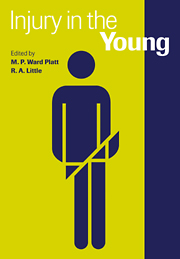Book contents
- Frontmatter
- Contents
- List of contributors
- Editors' Preface
- 1 The epidemiology of trauma involving children
- 2 Emergency room requirements for children
- 3 Child deaths in Accident and Emergency
- 4 Immediate life support
- 5 Evaluation of injury in children
- 6 Injuries of the developing brain
- 7 Wound healing in children
- 8 The lung after injury in children
- 9 Metabolic and endocrine stress responses to surgery
- 10 Head injury in children
- 11 Near drowning
- 12 The acute response to burn injury in children
- 13 Nutritional support of the severely burned child
- 14 Recovery, rehabilitation and the neuropsychological sequelae of head injury
- 15 Children's rights and child protection
- Index
5 - Evaluation of injury in children
Published online by Cambridge University Press: 18 September 2009
- Frontmatter
- Contents
- List of contributors
- Editors' Preface
- 1 The epidemiology of trauma involving children
- 2 Emergency room requirements for children
- 3 Child deaths in Accident and Emergency
- 4 Immediate life support
- 5 Evaluation of injury in children
- 6 Injuries of the developing brain
- 7 Wound healing in children
- 8 The lung after injury in children
- 9 Metabolic and endocrine stress responses to surgery
- 10 Head injury in children
- 11 Near drowning
- 12 The acute response to burn injury in children
- 13 Nutritional support of the severely burned child
- 14 Recovery, rehabilitation and the neuropsychological sequelae of head injury
- 15 Children's rights and child protection
- Index
Summary
The evaluation of an injured child is a process which has two distinct themes. These are:
The effect of the injury on the whole child.
The identification of the individual components of the injury.
The process of evaluation starts at the injury incident and may be initiated by the child itself. More often lay people, the attending parent or bystander, will evaluate the child's injury and its effect leading to a decision on whether to seek professional help. This process may then be repeated by an increasing series of professionals with differing skills, from the paramedic in the Ambulance Service to the staff in the Emergency department, the Trauma Surgeon and later the Rehabilitation Therapist.
Within this process of evaluation, both historical and physical information are necessary. The history of the incident itself is vital to an understanding of the forces involved and therefore the potential tissue damage caused by the incident. The child's own medical and trauma history reveals the baseline to which the new injury is added. Physical examination then completes the evaluation process. Evaluation leads to a choice of management and is also predictive, i.e. it suggests what further investigations may be needed, what level of hospital care will be required and the likely final outcome.
Triage
Triage is an evaluation and prioritisation process which ranks patients in order of need. It is an evaluation of the patient's injury in the context of prioritising the resources available to patients.
- Type
- Chapter
- Information
- Injury in the Young , pp. 48 - 73Publisher: Cambridge University PressPrint publication year: 1998



